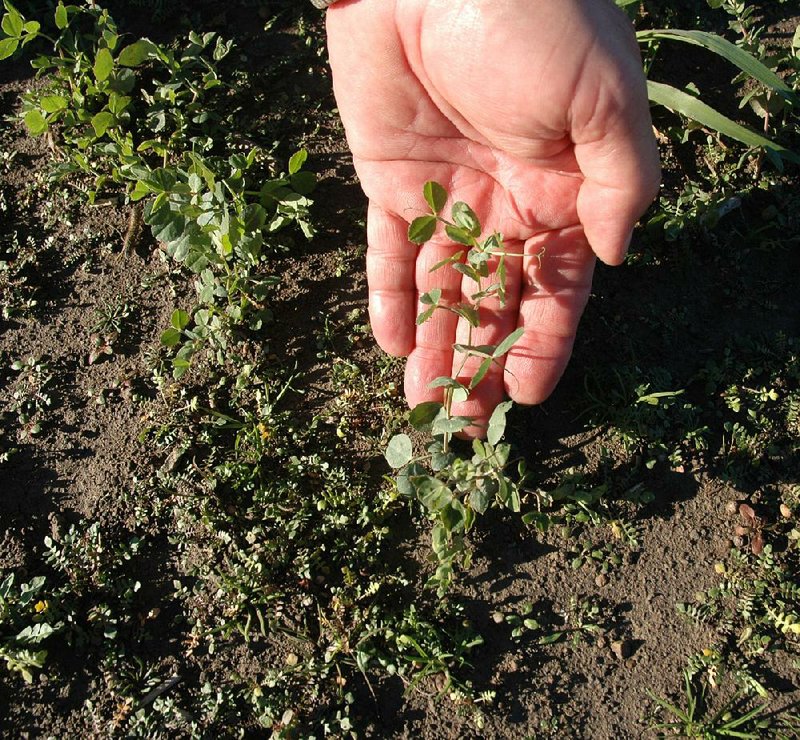WALNUT RIDGE -- Fred Schmidt apologized as he led the way to the field where his current crop was poking up through muddy ground.
"I expected it to be bigger than it is, but it's had a lot of rain on it," Schmidt said.
The crop in question is a mix of Austrian winter peas and black oats, and there's no market for it. Instead, its purpose is to reduce erosion and add nitrogen to the soil. If the cover crop works as intended, it could significantly reduce the cost of fertilizing the 24-acre field when Schmidt plants rice there next spring.
Schmidt is the first producer in the state to participate in a rice cover crop demonstration project by the University of Arkansas System Division of Agriculture and the federal Natural Resources Conservation Service. Two other rice producers had been scheduled to take part in the project this year, but heavy autumn rains prevented planting on their farms.
Trent Roberts, a UA soil scientist, said only a small percentage of Arkansas rice growers -- perhaps less than 1 percent --use winter cover crops.
"There's kind of this misperception that it's hard to implement cover crops into rice systems," Roberts said. "What we're trying to do is just demonstrate to producers that it can be done."
Two key obstacles are that rice is grown in flooded fields and that it leaves a bulky residue after harvesting, Roberts said. That means for a cover crop to be successful, it must be able to flourish in waterlogged soils and grow through the flattened rice residue, he said. Austrian winter peas, and a few other cover crops, fit the bill, Roberts said.
Timing is another consideration. Farmers who harvest their rice in August or September generally have plenty of time to plant a winter cover crop, Roberts said. Those who harvest after Oct. 1, he said, will have to work quickly to get their cover crop in.
That's especially true in North Arkansas, where winter cover crops generally have to be planted by Oct. 15, Roberts said.
Schmidt's cover crop was planted Oct. 14, just beating the deadline.
"We were planting during the [rice] harvest, which was a first for us," Schmidt said.
And then, for the first time in six weeks, it started to rain. Schmidt said 3.6 inches of rain fell on the field between planting and emergence on Nov. 1.
By Dec. 17, when he showed the field to a reporter, another foot of rain had fallen, Schmidt said. The peas were a couple of inches tall. The oats, planted to discourage geese from eating the peas, were taller.
There was no rice residue in the low-lying field because spring rains had prevented Schmidt from planting rice there. "Weather determines what we do and what the outcome is," he noted.
Cover crops can't help farmers cope with the vagaries of weather, Roberts said, but they can provide a measure of control over other variables.
They can help suppress weeds, Roberts said, an important consideration at a time when herbicide-resistant weeds are becoming a bigger problem in the state. They help retard soil erosion, which Roberts said can average 1 to 10 tons per year from row crop fields in Arkansas and can diminish surface water quality. Perhaps best of all from a rice grower's perspective, they are an inexpensive source of nitrogen.
Austrian winter peas can add 40 to 100 pounds of nitrogen per acre, Roberts said.
"When you think about a typical rice crop needing about 140 pounds of nitrogen per acre to produce a crop, that's a pretty significant reduction in producers' nitrogen fertilizer cost," he said. "Right now, a nitrogen fertilizer is going to run you about 45-50 cents a pound. Every pound that you can generate from a cover crop is potentially 50 cents you can save in nitrogen fertilizer."
Given that fertilization is the single-largest cost item for rice producers, the savings can be meaningful, Roberts said.
Rice is the state's largest agricultural commodity, so there's considerable interest in Roberts' work. The U.S. Department of Agriculture's Natural Resources Conservation Service gave him a $75,000 grant for the demonstration project, which was matched by RiceTec Inc. and Crop Protection Services.
In the spring, after Schmidt kills the cover crop with a herbicide, Roberts will measure nitrogen levels in the test field using a protocol developed by UA. Roberts will compare those results with soil samples he collected before the Austrian winter peas and black oats were planted to determine how much nitrogen fertilizer Schmidt will need when he puts in his 2016 rice crop. Roberts also will track this year's yields to determine whether the experiment increased the test field's productivity.
It's important the demonstration project show positive results, Roberts said, since cover crops can add significantly to a farmer's workload.
"You're basically asking them to plant a whole other crop and terminate a whole other crop," he said. "You've got to show them how they can benefit from that increased management."
Schmidt thinks it will take several years to determine the true value of cover crops to rice growers.
He has a longstanding interest in improving the quality of his soil, so he is willing to let the cover crop experiment play out. But he also has to keep a close watch on the bottom line.
"The first goal is to grow more dollars' worth of rice than it costs" to manage the cover crop, Schmidt said, eyeing the small but growing clump of winter peas at his feet. "I'm all for soil health, but the only thing I can put in the bank is a check."
Business on 01/01/2016
